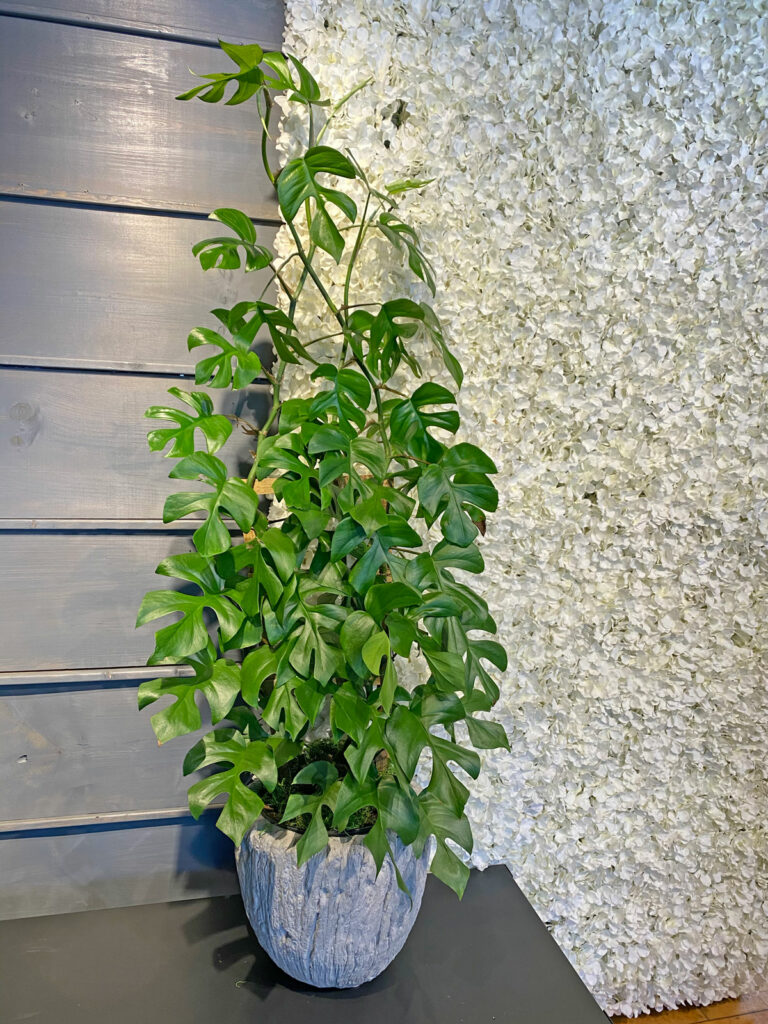To make a Rhaphidophora Tetrasperma bushier, prune the plant regularly and encourage new growth by providing proper care and light conditions. Rhaphidophora Tetrasperma, also known as Mini Monstera or Philodendron Ginny, is a popular houseplant known for its lush and bushy appearance.
If you want to promote bushier growth in your Rhaphidophora Tetrasperma, regular pruning is key. Trim back leggy stems and remove any dead or damaged leaves to encourage new growth. Place your plant in a bright spot with indirect sunlight and maintain a consistent watering routine, allowing the top inch of soil to dry out before watering again.
By following these care tips and giving your Rhaphidophora Tetrasperma the love and attention it needs, you can enjoy a fuller and bushier plant over time.

Credit: sproutsandstems.com
Introduction To Rhaphidophora Tetrasperma Bushier
Rhaphidophora Tetrasperma, also known as the Mini Monstera or Ginny Philodendron, is a popular houseplant. A bushier Rhaphidophora Tetrasperma can enhance the beauty of your indoor space. This plant has glossy, green leaves and a vining growth habit. It is relatively low-maintenance and can thrive in a variety of light conditions.
To encourage bushier growth, you can prune the plant regularly, allowing it to branch out. Additionally, providing proper nutrition and watering the plant when the topsoil feels dry can promote its overall health. Rhaphidophora Tetrasperma is a versatile plant that can be displayed in various ways, such as hanging baskets or trellises.
With its lush foliage and compact size, it can be an eye-catching addition to any room. Consider implementing these tips to make your Rhaphidophora Tetrasperma even bushier and more vibrant.
Understanding The Growth Habits Of Rhaphidophora Tetrasperma
One key aspect to making Rhaphidophora Tetrasperma bushier is understanding its growth habits. Light, temperature, and humidity play crucial roles in promoting fuller growth. Bright, indirect light will encourage the plant to produce more foliage, while low light can result in sparse growth.
The ideal temperature range for this plant is between 65-85 degrees Fahrenheit, allowing it to thrive in a warm environment. In terms of humidity, Rhaphidophora Tetrasperma prefers higher levels, around 60-70%. This can be achieved by misting the leaves or placing the plant on a tray filled with water and pebbles.
By considering these factors and providing the right conditions, you can help your Rhaphidophora Tetrasperma become bushier and more vibrant.
How to Make Rhaphidophora Tetrasperma Bushier: Step by Step Guide
Pruning Techniques To Enhance Bushiness
Pruning is a crucial technique to enhance the bushiness of Rhaphidophora Tetrasperma plants. By following a step-by-step guide, you can achieve bushier growth. Start by identifying the appropriate stems to prune, ensuring you have the proper tools and techniques. Pruning not only promotes healthier growth but also helps shape the plant.
Regular pruning will stimulate new growth, leading to a fuller and more vibrant bush. Removing dead or damaged leaves and stems also prevents the spread of diseases and pests. Additionally, pruning allows light to reach the lower parts of the plant, promoting overall growth.
By following these tips and consistently pruning your Rhaphidophora Tetrasperma, you can create a stunning and lush bushy plant. Enjoy the rewards of your efforts with a beautiful and thriving indoor greenery.
Propagation Methods For Multiplying Rhaphidophora Tetrasperma
Propagating Rhaphidophora Tetrasperma can result in bushier plants. One way is through stem cuttings, where you take a portion of the plant stem and let it root in water or soil. Another method is air layering, where you create a root system on a portion of the stem while it is still attached to the parent plant.
And finally, you can divide the rhizomes of the plant to create new ones. Each method has its own advantages, so experimenting with all three can help you achieve the bushier look you desire for your Rhaphidophora Tetrasperma. Consider trying these propagation techniques to enjoy fuller and more vibrant plants in your home or garden.
Understanding Fertilization And Nutrient Requirements
Fertilization and nutrient requirements play a crucial role in promoting bushier growth in Rhaphidophora Tetrasperma. Choosing the right fertilizers is essential to provide the necessary nourishment to the plant. Proper fertilization techniques ensure optimum bushiness in the plant, enhancing its overall appearance.
By understanding the nutrient requirements of Rhaphidophora Tetrasperma, you can effectively meet its needs and encourage bushier growth. It is important to ensure that the fertilizers used are rich in the specific nutrients required by the plant for healthy and vigorous growth.
Following appropriate fertilization techniques, such as using fertilizers in the correct quantities and at the right intervals, can promote the desired bushiness in Rhaphidophora Tetrasperma. By providing the plant with the necessary nutrients, you can help it thrive and achieve a beautiful, compact shape.
Creating Optimal Growing Conditions
To make a Rhaphidophora Tetrasperma bushier, it’s essential to create optimal growing conditions. First, provide the right amount of light, ensuring it gets sufficient but not excessive sunlight. Next, maintain appropriate temperature and humidity levels, ensuring they stay within the plant’s preferred range.
Additionally, finding the ideal potting mix and container is crucial. Use a well-draining mix that retains moisture without becoming waterlogged. Choose a container with adequate drainage to prevent root rot. By following these guidelines, you can encourage your Rhaphidophora Tetrasperma to grow bushier and thrive.
So, give your plant the right conditions it needs to flourish, and you’ll soon enjoy a fuller and more robust plant.
Common Issues And Troubleshooting Tips
Rhaphidophora Tetrasperma is a popular houseplant, but it can sometimes struggle to achieve bushy growth. One common issue is pest infestation, which can hinder the plant’s growth and overall health. To prevent this, regularly inspect your plant for signs of pests and take immediate action if any are found.
Another issue that affects bushiness is diseases, such as fungal infections or root rot. Ensure that you water your plant properly and avoid overwatering to prevent these issues. If you notice slow or stunted growth, it may be due to nutrient deficiencies.
Consider using a balanced fertilizer to provide the necessary nutrients for healthy growth. Finally, provide your Rhaphidophora Tetrasperma with adequate sunlight and ensure it has enough space to grow. Following these troubleshooting tips will help you maintain a bushy and healthy plant.
Tips For Regular Care And Maintenance
Rhaphidophora Tetrasperma is a popular houseplant known for its lush and bushy appearance. To ensure its optimal growth, regular care and maintenance are essential. One important aspect is proper watering and watering techniques. The plant should be watered regularly, but not excessively, as overwatering can lead to root rot.
Additionally, it is crucial to use well-draining soil and allow the top inch of soil to dry out before watering again. Pruning and grooming are also vital for ongoing bushiness. By trimming back any leggy or overgrown stems, you encourage the plant to grow denser and fuller.
Lastly, regular monitoring for signs of stress or nutrient deficiencies is crucial. Keep an eye out for yellowing leaves or stunted growth, as these may indicate a need for adjustments in lighting, fertilization, or overall care.
Frequently Asked Questions On How To Make Rhaphidophora Tetrasperma Bushier
How Do I Make My Rhaphidophora Tetrasperma Bushier?
To make your Rhaphidophora Tetrasperma bushier, you can trim the stems just above a node, stimulate new growth by providing adequate light, water, and nutrients, and provide support for the plant to encourage upward growth. Regular pruning and training can help create a bushier appearance.
How Often Should I Water My Rhaphidophora Tetrasperma To Encourage Bushier Growth?
Water your Rhaphidophora Tetrasperma when the top inch of soil feels dry. Overwatering can lead to root rot and hinder growth. Aim for consistent sliightly moist soil which encourages bushier growth without causing waterlogged conditions.
How Much Light Does Rhaphidophora Tetrasperma Need To Become Bushier?
Rhaphidophora Tetrasperma requires bright but indirect light for optimal growth. An east-facing window or filtered light from a sheer curtain is ideal. Avoid placing the plant in direct sunlight as it can scorch the leaves and hinder bushier growth.
Conclusion
Mastering the art of making your Rhaphidophora Tetrasperma bushier is essential for plant enthusiasts. By following the proven techniques mentioned in this blog post, you can take your plant care skills to new heights. Pruning your plant regularly, providing adequate light and humidity, and ensuring proper soil conditions are crucial for encouraging bushier growth.
Remember to trim the excess leaves and stems that hinder your plant’s growth, promoting the development of new shoots and side branches. Moreover, be mindful of the position of your plant and adjust it accordingly to maximize light exposure on all sides.
Your Rhaphidophora Tetrasperma will thrive when placed in a warm and humid environment, so investing in a humidifier and misting it occasionally will do wonders. With these tips in hand, you are now armed with the knowledge needed to make your Rhaphidophora Tetrasperma bushier and transform it into a stunning display of nature’s beauty.

